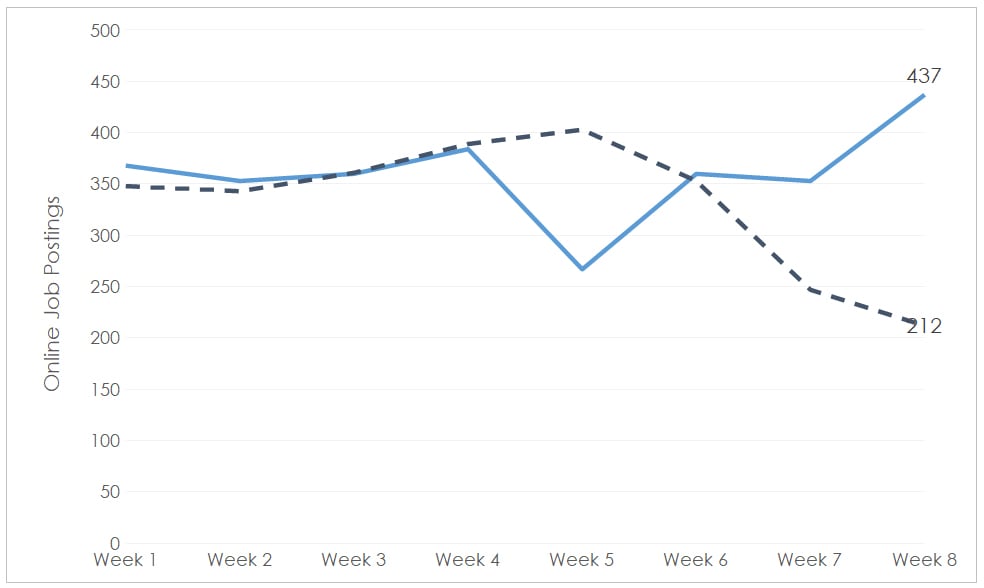As part of NWPB’s ongoing effort to provide updates on the impact of COVID-19, this briefing note outlines how local job demand has changed amid the current pandemic.
NWPB’s data is based on the aggregation of online job postings. The reference period begins in the first week of February for 2019 and 2020 and ends with the fourth full week of March. While this method does not reflect all job demand in Niagara (i.e. it cannot track word-of-mouth job demand or recruiting through private job boards) it remains a useful indicator of general trends within the local labour market.
NWPB finds that Niagara’s week-over-week job demand trends began to change during the week of March 15, 2020. Compared to the same week in 2019, local job demand decreased by 30%. During the week of March 22, 2020, measurable job demand decreased by 51.5% compared to 2019. These changes in demand occurred alongside a Declaration of Emergency for Ontario on March 17, 2020, and an order to close non-essential businesses on March 24, 2020.

Job opportunities in Niagara continue to present themselves, despite the impact of the COVID-19 Coronavirus. Data from March 15, 2020 to March 28, 2020 capture the six occupation groups whose demand represent at least five percent of total measurable job demand during this two week period.
| Occupation | Job Posts | Percentage |
|---|---|---|
| Other customer and information services representatives | 25 | 5.7% |
| Retail salespersons | 22 | 5.1% |
| Registered nurses and registered psychiatric nurses | 22 | 5.1% |
| Sales and account representatives – wholesale trade (non-technical) | 22 | 5.1% |
| Home support workers, housekeepers and related occupations | 22 | 5.1% |
| Retail sales supervisors | 22 | 5.1% |
The occupation group most in demand – other customer and information services representatives – includes a number of customer support positions that are work-from-home opportunities. Some of these job posts are from large-scale employers engaged in a hiring campaign. As such, there are likely many more job opportunities in this group than measurable demand might suggest.
Job demand for retail salespersons did not appear to be work-from-home opportunities. This suggests that the work was likely for employment within essential services offering curbside sales, online sales fulfillment, or in-person sales. However, demand within this occupation was evenly split between jobs posted during the Week of March 15th and the week of March 22nd. Since the week of March 22nd saw the introduction of mandatory shutdowns of non-essential businesses, it is possible that some demand noted during this period did not materialize into actual job offers. For example, a retail sales posting from a non-essential sector posted on March 22nd is likely to have been withdrawn once emergency shutdowns were imposed. NWPB will closely monitor job demand in this occupation, as well as in retail sales supervisors, in the coming weeks to see if demand continues.
Compared the last two weeks of March in 2019, job demand for registered nurses was slightly increased. Demand for home support workers in the final two weeks of March 2020 was double the job demand seen during the same time in 2019. This demand is not surprising given the increased pressure that the COVID-19 pandemic has placed on the health care system.
At the same time NWPB gathered these data, Niagara’s twelve municipalities and the Regional Municipality of Niagara deployed the Niagara COVID-19 Business Impact Survey.[1] This survey engaged with 2,604 local employers to gain an understanding of how this pandemic has affected their operations. Foremost among the findings was that 97% of respondents were affected by the COVID-19 pandemic. Additionally, 92% of respondents noted that they had lost revenue because of the pandemic. Among the respondents who lost revenue, 43% reported that they had lost between 76 and 100% of their revenue. This survey also asked respondents if they had reduced their staffing as a result of COVID-19. Among those employers who responded 65.9% indicated the virus had resulted in staffing reductions. Where employers reported the extent of their full-time staff reductions, 54.9% of employers reported reductions off between 76% and 100% of full-time staff.
While revenue losses were not equally distributed across all industry sectors, the scope of this shock to the local economy will require close consideration in the days to come. As such, NWPB will be updating this briefing note at regular intervals as a means of determining any industry sectors that are able to continue operations and hiring amid these challenging times.
What to do in Uncertain Times
Individuals experiencing employment disruptions, as well as employers who are still looking to hire, can access resources and support from Niagara’s Employment Ontario service providers. Contact information for a service provider near you can be found through this link.
For all other inquiries please contact Vivian Kinnaird.
[1]: NWPB gratefully acknowledges the efforts of Niagara’s twelve municipalities and the Regional Municipality of Niagara in delivering this survey.